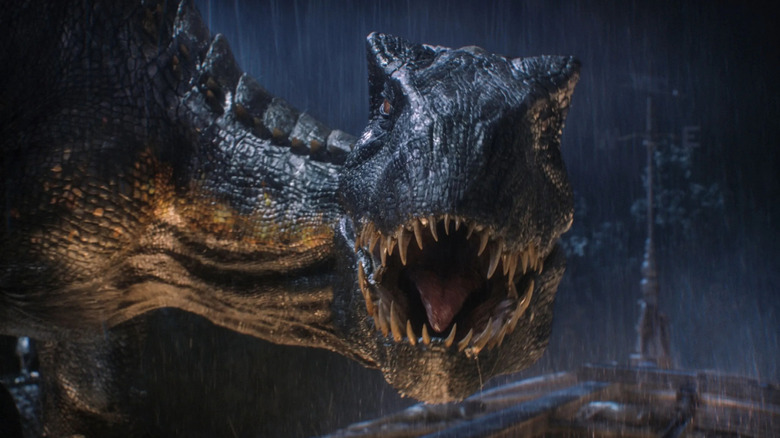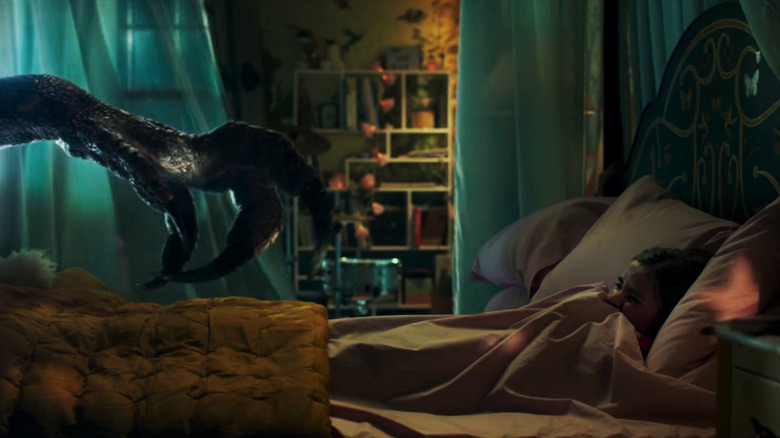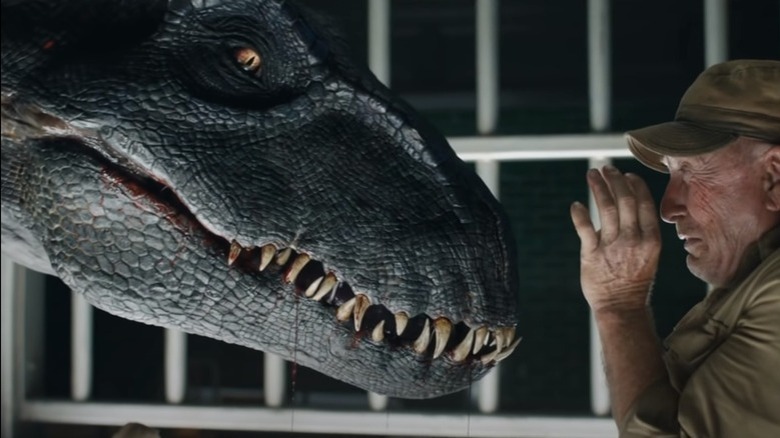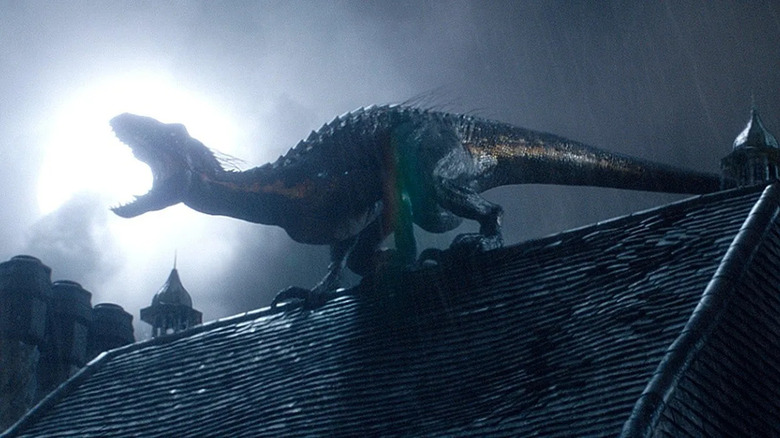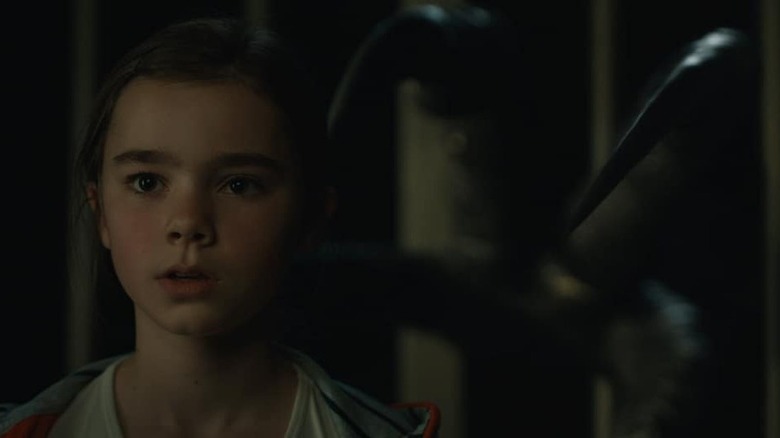The Classic Horror Movies That Inspired Jurassic World: Fallen Kingdom
Director J.A. Bayona's "Jurassic World: Fallen Kingdom" is an unusual entry in the renowned "Jurassic" series. While Steven Spielberg's original "Jurassic Park" had scary moments, overall the film is a rollicking adventure. "Jurassic World: Fallen Kingdom" has a more dark, somber tone throughout, beginning with the dinosaurs facing a second extinction from a deadly volcano. Much like "Jurassic Park," the first scene in "Fallen Kingdom" has a dark, moody atmosphere and a deadly monster lurking unseen; like the opening scene in the original movie, in Bayona's film, a giant T-Rex ominously appears in the flashes of lightning and attacks her prey. Unlike "Jurassic Park," however, the film only builds on this atmosphere, becoming increasingly horror-like rather than shifting tonally towards adventure.
The second half of "Jurassic World: Fallen Kingdom" takes place inside Sir Benjamin Lockwood's mansion and is influenced by classic horror films. Again, Spielberg's "The Lost World: Jurassic Park" also shows dinosaurs infiltrating the domestic spaces of humans with a T-Rex stomping through the metropolis of San Diego — but the Lockwood setting has more of a confined, spooky feeling that supports the old-fashioned monster-movie aesthetic. Bayona elaborates on his nightmarish visual approach in Bloody Disgusting:
"For me, one of the intentions was going back to the original 'Jurassic Park' and the kind of suspense that Steven played in the second half. We all remember the scene of the velociraptors chasing the kids in the kitchen. For me it was a chance of playing suspense and the space in a more interesting way, playing with claustrophobia and tighter locations."
The director makes visual and narrative references to several key films in the horror genre.
Nosferatu and Dracula
Bayona homages one of cinema's earliest horror films, F. W. Muranu's "Nosferatu," in a near-identical shot of the Indoraptor's long claws methodically reaching out for Maisie cowering in her childhood bed. Bayona emulates "Nosferatu" by using stark shadows to elicit the creeping fear of a killer approaching. In one shot, lightning illuminates the menacing profile of the vicious Indoraptor looming over the terrified little girl. Bayona elaborates on this frightening sequence in IndieWire:
"If you think about kids playing with dinosaurs, most of the time they play in their bedrooms, so it was like a fantasy of a kid becoming a reality. ... I wanted him to be very dark and disappear in darkness. I put myself in the position of a kid and what would be scary: the eyes and the teeth."
Bayona also draws inspiration from John Badham's 1979 "Dracula." He tells Empire:
"I saw that movie at five years old, by accident of course, and I couldn't live close to a window for months because I thought that Frank Langella was going to come in. Colin had that same moment in the script, and I really made something about that scene, thinking about that moment in my life."
The framing of the scenes are very similar: A bloodthirsty predator climbs on top of a mansion roof and tries to open the window from an upside-down position. Shrouded in moonlight, the shadow of its grasping hand (or claw) searches for the window handle. Bayona mirrors how Badham masterfully builds tension by intercutting between the young woman hiding beneath the covers and the menacing hand drawing near. These back-and-forth shots of the predator getting closer and closer to its victim are intense and terrifying.
Frankenstein
Entrusted with the Lockwood fortune, Sir Benjamin's assistant Eli is blinded by capitalistic greed and exploits the dinosaurs by selling them to the highest bidder. This includes a new creation, the Indoraptor, genetically modified from an Indominus Rex and Velociraptor. As with Dr. Frankenstein's monster, the Indoraptor was recklessly created in a laboratory and lives a tortured existence. Kept in isolation for so long, the creature is emotionally unstable and incredibly lethal. Bayona's biggest inspiration for the character was Boris Karloff's portrayal in "Frankenstein" and Bernie Wrightson's illustrated adaptation of the Mary Shelley novel (via Cinema Blend).
On the surface, the Indoraptor is just as mighty and foreboding as Karloff's monster, but he does not have the same sympathetic childlike innocence. Instead, the dinosaur has a sadistic streak that lets him trick and ensnare unsuspecting victims — much closer to Shelley's bold, intelligent, and enraged conception of Frankenstein's monster. "Jurassic Park: Fallen Kingdom," and the entire series, touches on the creationist themes of "Frankenstein" where a beast created by man is cruelly unleashed into a dangerous world.
The Hunchback of Notre Dame & a classic Hollywood trope
At the center of many Gothic horror stories is a mansion where something mysterious lurks around every corner. Bayona is no stranger to films about haunted houses, earning critical acclaim for "The Orphanage," which is about a woman haunted by ghosts in her childhood home. In IndieWire, Bayona comments on his use of the horror genre staple during the "Jurassic World: Fallen Kingdom" climax:
"All great classic stories end up on top of the castle or the cathedral. Lighting and playing with the idea of the glass cracking has this Gothic element that I really like."
The Indoraptor chases Maisie on top of Lockwood manor. The soft glow of lights from the windows against the gloomy sky gives the shot an eerie feeling. While prowling the roof, the dinosaur's curled body brings to mind the gargoyles that so frequently adorn Gothic architecture — like those seen in 1939 version of "The Hunchback of Notre Dame," which ends with Quasimodo asking the gargoyles, "Why was I not made of stone, like thee?"
The climax setup is also classic Hollywood. There are so many confrontations in horror, thriller, and even noir films that occur in dangerous locations — like on top of buildings — because it heightens the stakes. (Even the 1927 adaptation of "The Hunchback of Notre Dame," for example, ends with Quasimodo throwing Jehan off of the cathedral roof.) Not only are you being pursued by a villain, but you could plunge to your death at any moment; either way, the villain wins. The setting is visually and narratively exciting, which is probably why it can be found in so many movie climaxes — from Alfred Hitchcock's "Vertigo" to Disney's "Beauty and the Beast."
The Wolf Man
Inside the Magic muses that the "beautifully-framed shot of the Indoraptor roaring against a full moon" on the roof is a homage to "The Wolf Man," and there is indeed something distinctly canine about this dinosaur. Bayona wanted the Indoraptor to evoke "a mangy, rabid street dog ... incredibly lean and malnourished and slightly unhinged" (via IndieWire).
But unlike the Wolf Man from Universal's 1941 film, there is no dual nature at play. When Larry Talbot transforms into the werewolf in "The Wolf Man," he is driven to a frenzied rage — but the rest of the time, he is a good person, seeking a cure. Although the Indoraptor is intelligent, he does not have a trace of humanity. There is no empathy nor a capacity to bond with others. The Indoraptor lives in a constant state of violence — seemingly enjoying hurting others, as seen when he toys with Ken Wheatley.
The Indoraptor is one of the most memorable additions to the "Jurassic Park" lore, thanks to its viciousness and unique characterization. This is thanks, in part, to Bayona's consistent use of horror iconography, which — love it or hate it — makes "Jurassic World: Fallen Kingdom" unlike any other film in the franchise.
